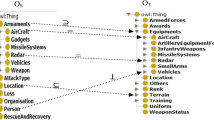Abstract
The most ground approach to solve the ontology heterogeneous problem is to determine the semantically identical entities between them, so-called ontology matching. However, the correct and complete identification of semantic correspondences is difficult to achieve with the scale of the ontologies that are huge; thus, achieving good efficiency is the major challenge for large- scale ontology matching tasks. On the basis of our former work, in this paper, we further propose a scalable segment-based ontology matching framework to improve the efficiency of matching large-scale ontologies. In particular, our proposal first divides the source ontology into several disjoint segments through an ontology partition algorithm; each obtained source segment is then used to divide the target ontology by a concept relevance measure; finally, these similar ontology segments are matched in a time and aggregated into the final ontology alignment through a hybrid Evolutionary Algorithm. In the experiment, testing cases with different scales are used to test the performance of our proposal, and the comparison with the participants in OAEI 2014 shows the effectiveness of our approach.


Similar content being viewed by others
References
Rahm E (2011) Towards large-scale schema and ontology matching. Schema matching and mapping, pp 3–27
Verhoosel JPC, van Bekkum M, van Evert FK (2015) Ontology matching for big data applications in the smart dairy farming domain. Ontology matching, pp 55–59
Seidenberg J, Rector A (2006) Web ontology segmentation: analysis classification and use. In: Proceedings of the 15th international conference on World Wide Web. Edinburgh, Scotland UK, pp 13–22
Moscato P (1979) On evolution, search, optimization, gas and martial arts: toward memetic algorithms, Technical Report 826, California Inst. Technol., Pasadena, CA, Tech. Rep. Caltech Concurrent Comput. Prog. Rep
Do HH, Rahm E (2007) Matching large schemas: approaches and evaluation. Inf Syst 32(6):857–885
Hu W, Qu Y, Cheng G (2008) Matching large ontologies: a divide-and-conquer approach. Data Knowl Eng 67(1):140–160
Hamdi F, Safar B, Reynaud C, Zargayouna H (2010) Alignment-based partitioning of large-scale ontologies. Adv Knowl Discov Manag 292:251–269
Seddiquia MH, Aono M (2009) An efficient and scalable algorithm for segmented alignment of ontologies of arbitrary size. Web Semant 7(4):344–356
Zhong Q, Li H, Li J et al (2009) A gauss function based approach for unbalanced ontology matching. In: Proceedings of the 2009 ACM SIGMOD international conference on management of data. Providence, RI, USA, pp 669–680
Xue X, Wang Y (2015) Optimizing ontology alignments through a memetic algorithm using both matchfmeasure and unanimous improvement ratio. Artif Intell 223:65–81
Xue X, Wang Y (2016) Using memetic algorithm for instance coreference resolution. IEEE Trans Knowl Data Eng 28(2):580–591
Acampora G, Loia V, Salerno S et al (2012) A hybrid evolutionary approach for solving the ontology alignment problem. Int J Intell Syst 27:189–216
Euzenat J, Valtchev P (2004) Similarity-based ontology alignment in owl-lite. In: 16th European conference on artificial intelligence proceeding. Valencia, Spain, pp 333–337
Miller GA (1995) Wordnet: a lexical database for english. Commun ACM 38(11):39–41
Stoilos G, Stamou G, Kollias S (2005) A string metric for ontology alignment. In: Proceedings of 4th international semantic web conference (ISWC 2005). Galway, Ireland, pp 623–637
Winkler W (1999) The state record linkage and current research problems. Statistics of Income Division
Melnik S, Garcia-Molina H, Rahm E (2002) Similarity flooding: a versatile graph matching algorithm and its application to schema matching. In: 18th international conference on data engineering. Shanghai, China, pp 117–182
Acampora G, Loia V, Vitiello A (2013) Enhancing ontology alignment through a memetic aggregation of similarity measures. Inf Sci 250:1–20
Fernandez M, Overbeeke C, Sabou M et al (2009) What makes a good ontology? A case-study in fine-grained knowledge reuse. Springer, Berlin
Ros F, Guillaume S (2016) DIDES: a fast and effective sampling for clustering algorithm. Knowledge and information systems, pp 1–26
Yuruk N, Mete M, Xu X, Schweiger TAJ (2009) AHSCAN: agglomerative hierarchical structural clustering algorithm for networks. In: International conference on advances in social network analysis and mining. Greece, Athens, pp 72–77
Rijsbergen CV (1979) Information retrieval, 2nd edn. Butterworths, London
Dragisic Z, Eckert K, Euzenat J et al (2014) Results of the ontology alignment evaluation initiative 2014. In: Proceedings of the 9th international workshop on ontology matching collocated with the 13th international semantic web conference. Trentino, Italy, pp 1–44
Acknowledgements
This work is supported by the National Natural Science Foundation of China (Nos. 61503082 and 61402108), Natural Science Foundation of Fujian Province (No. 2016J05145) and China Scholarship Council.
Author information
Authors and Affiliations
Corresponding author
Rights and permissions
About this article
Cite this article
Xue, X., Pan, JS. A segment-based approach for large-scale ontology matching. Knowl Inf Syst 52, 467–484 (2017). https://doi.org/10.1007/s10115-016-1018-9
Received:
Accepted:
Published:
Issue Date:
DOI: https://doi.org/10.1007/s10115-016-1018-9




